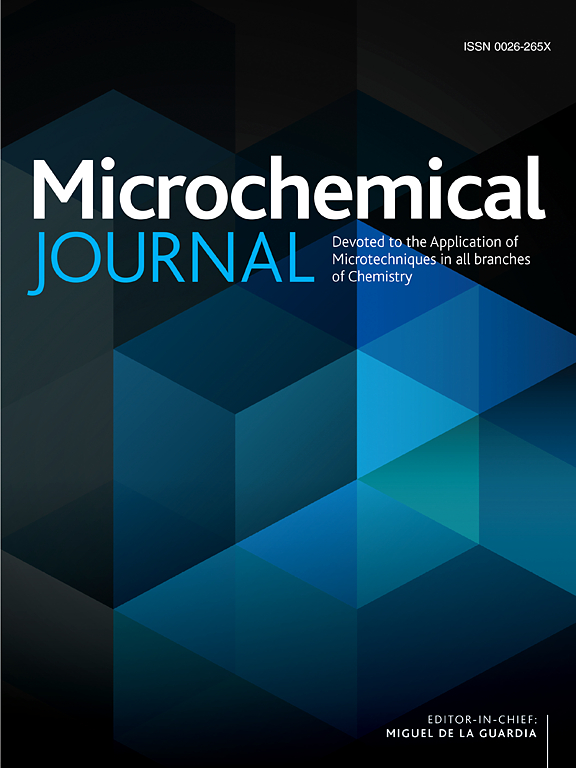On-chip microextraction of N-acetylcysteine in water and plasma samples and smartphone-enabled colorimetric determination
IF 4.9
2区 化学
Q1 CHEMISTRY, ANALYTICAL
引用次数: 0
Abstract
Recent advances in microfluidics have made it possible to carry out expensive tests on a small chip. In this context, the use of smartphones as mainly colorimetric detectors has provided the promise of complete transfer of the analytical chemistry process from sample preparation to detection on microfluidic chips. In this research, a microfluidic chip has been used as a platform for the extraction and smartphone-enabled colorimetric measurement of N-acetylcysteine (NAC). The extraction phase was a deep eutectic solvent based on 1,10-phenanthroline and thymol with a molar ratio of 1:2 (a type V deep eutectic solvent). Analyte determination was done indirectly in this work. NAC reduces Fe3+ ions to Fe2+ on the chip, and the produced Fe2+ selectively forms a red-orange complex with 1,10-phenanthroline in the extraction deep eutectic solvent phase. The results showed that the intensity of red color in the extraction phase depends directly on the analyte concentration. In this way, measuring NAC in the concentration range of 9.0 μg L−1 to 0.5 mg L−1 was possible. The calibration curve was bilinear and the sensitivity of the method was better at the lower concentrations (lower concentration range slope: 29.812, higher concentration range slope: 9.627). The method's detection limit was 3.0 μg L−1 and the quantification limit was 9.0 μg L−1. The method was validated after evaluating the effect of possible interferences in the tap water and plasma matrixes. The results showed that the method provides high accuracy (recovery percentage: 96.6–107.5 %) and high precision (coefficient of variation: 0.46–1.90 %) for determining NAC in the investigated real samples.

水和血浆样品中n-乙酰半胱氨酸的芯片微萃取和智能手机的比色测定
微流体学的最新进展使得在一个小芯片上进行昂贵的测试成为可能。在这种情况下,使用智能手机作为主要的比色检测器提供了从样品制备到微流控芯片检测的分析化学过程的完全转移的希望。在这项研究中,微流控芯片已被用作提取和智能手机支持比色测量n -乙酰半胱氨酸(NAC)的平台。萃取相为以1,10-菲罗啉和百里酚为基料的深共晶溶剂,摩尔比为1:2 (V型深共晶溶剂)。分析物的测定是间接进行的。NAC将芯片上的Fe3+离子还原为Fe2+,生成的Fe2+在萃取的深共晶溶剂相中选择性地与1,10-菲罗啉形成红橙色配合物。结果表明,萃取相的红色强度与分析物的浓度直接相关。这样可以在9.0 μg L−1 ~ 0.5 mg L−1的浓度范围内测量NAC。在低浓度条件下(低浓度范围斜率为29.812,高浓度范围斜率为9.627),该方法的灵敏度较好。方法检出限为3.0 μ L−1,定量限为9.0 μ L−1。通过对自来水和等离子体基质中可能存在的干扰的影响进行评估,验证了该方法的有效性。结果表明,该方法具有较高的准确度(回收率为96.6 ~ 107.5%)和精密度(变异系数为0.46 ~ 1.90%)。
本文章由计算机程序翻译,如有差异,请以英文原文为准。
求助全文
约1分钟内获得全文
求助全文
来源期刊

Microchemical Journal
化学-分析化学
CiteScore
8.70
自引率
8.30%
发文量
1131
审稿时长
1.9 months
期刊介绍:
The Microchemical Journal is a peer reviewed journal devoted to all aspects and phases of analytical chemistry and chemical analysis. The Microchemical Journal publishes articles which are at the forefront of modern analytical chemistry and cover innovations in the techniques to the finest possible limits. This includes fundamental aspects, instrumentation, new developments, innovative and novel methods and applications including environmental and clinical field.
Traditional classical analytical methods such as spectrophotometry and titrimetry as well as established instrumentation methods such as flame and graphite furnace atomic absorption spectrometry, gas chromatography, and modified glassy or carbon electrode electrochemical methods will be considered, provided they show significant improvements and novelty compared to the established methods.
 求助内容:
求助内容: 应助结果提醒方式:
应助结果提醒方式:


